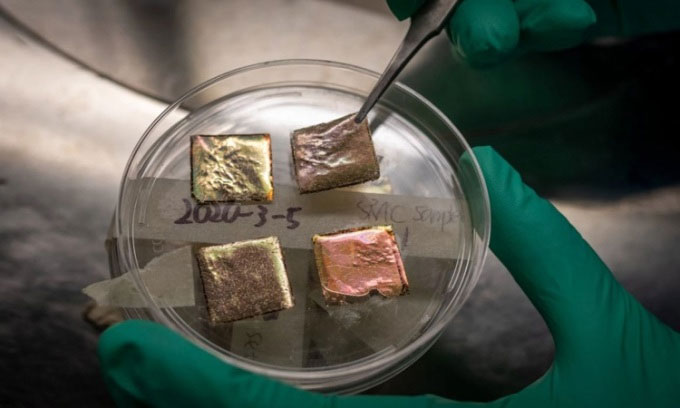A team of engineers from the Berkeley lab has developed a roof coating that can make buildings warmer or cooler depending on the weather.
When it is hot, the material reflects sunlight and heat. However, this cooling feature through reflection automatically stops in winter. As a result, the new material helps reduce the energy needed for heating and cooling.

TARC coating sample. (Photo: Thor Swift/Berkeley Lab)
The reflective cooling system works by drawing thermal radiation out of the building and dispersing it into the atmosphere. Since these wavelengths can pass through the atmosphere, the heat dissipates into space immediately. Other versions use reflective surfaces like super-white paint to scatter sunlight and heat, keeping the building cooler. While such systems work well for cooling homes in the summer, they also make the house colder in the winter.
In a study published on December 16 in the journal Science, the engineering team at Berkeley Lab developed a coating that automatically switches to retain heat when temperatures drop. They call this material temperature-adaptive reflective coating (TARC). The key to this technology is a peculiar compound known as vanadium dioxide (VO2). In 2017, the research team discovered the unusual properties of VO2. When it reaches 67 degrees Celsius, the material conducts electricity but does not transfer heat, contrary to known physical laws.
The researchers’ idea is that when the weather warms up, the material will absorb and reflect light. But when it gets cold, the material will allow heat to transfer directly from the sun to the building. The researchers experimented with TARC panels about two square centimeters in size, then compared them with samples of dark and white roofing materials. They used wireless devices to measure changes in direct light and temperature.
TARC performed better than expected. According to the measurement results, TARC reflects about 75% of sunlight regardless of the weather, but when the surrounding temperature is above 30 degrees Celsius, the material dissipates 90% of heat into the air. If the temperature drops below 15 degrees Celsius, TARC only dissipates about 20% of the heat. Using the collected data, the research team simulated how TARC would operate year-round in 15 different climate zones across the United States and estimated that a household in the U.S. could save an average of about 10% on electricity bills by using TARC.
The research team stated that TARC could be adapted for use as thermal regulation materials in cars, electronic devices, satellites, and even tent fabrics or clothing. Next, the researchers will conduct experiments using larger TARC prototypes to test the practicality of using the material as a roofing coating.


















































